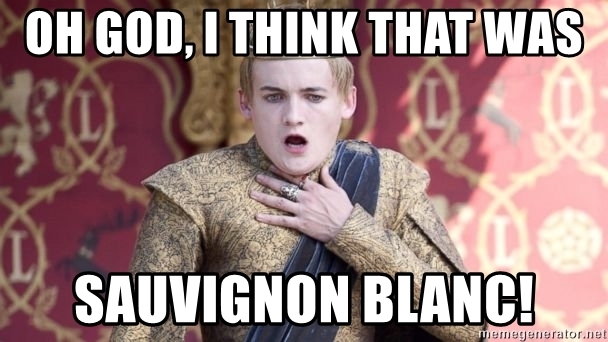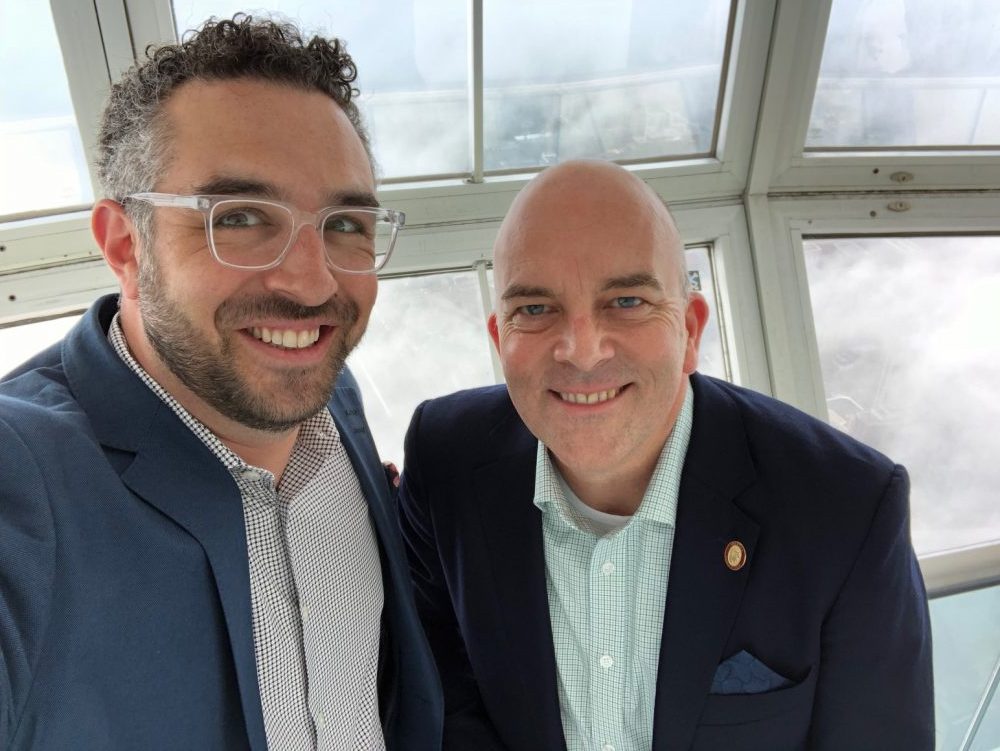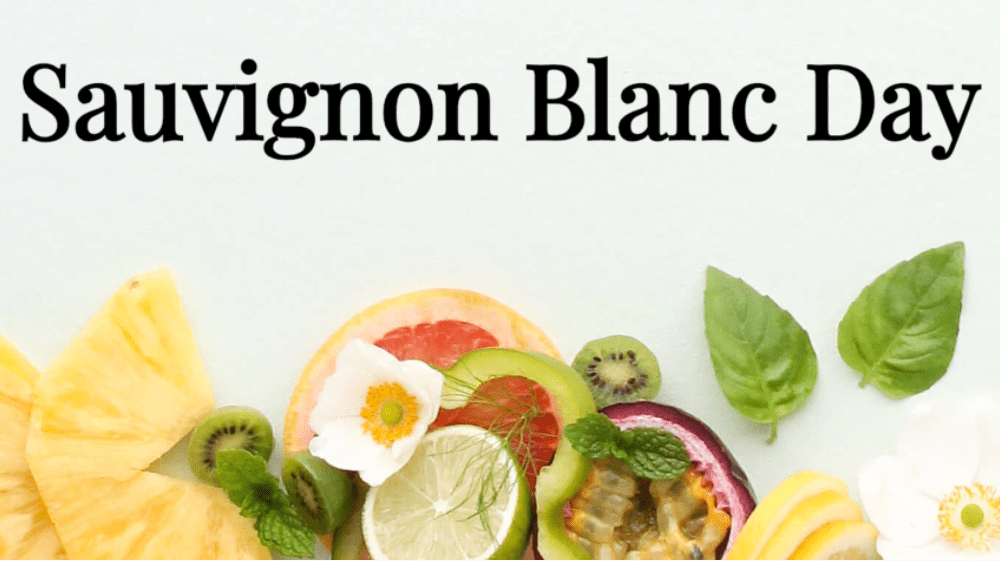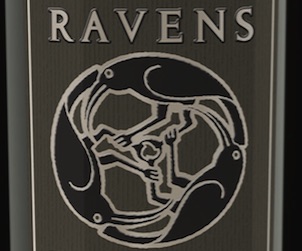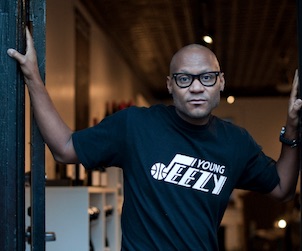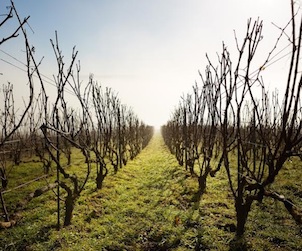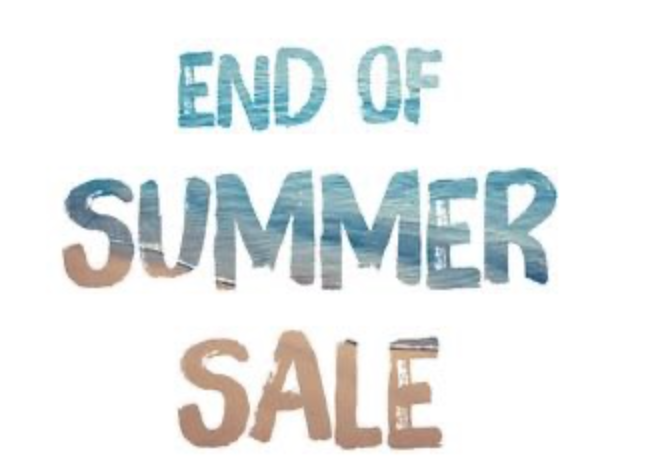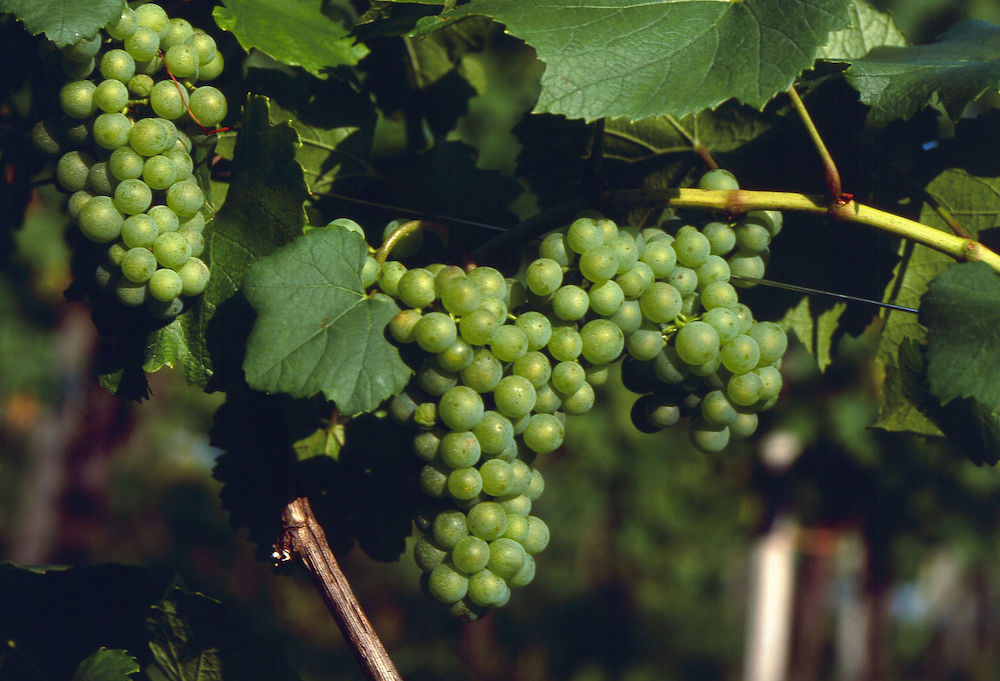
Some Sauvignon Blanc grapes hanging about on the vine getting all worked up about World Sauvignon Blanc Day on May the 4th.
What with International Sauvignon Blanc Day upon us tomorrow, Saturday the 4th of May, I thought it was a timely moment for a reconsideration of this much-beloved and yet, inversely, much-maligned varietal.
There is no doubt that it can be a very polarising grape, call it the cilantro of the wine world if you will ; some people just cannot get enough of the stuff, whilst other think that it tastes almost perfumed, akin to the scent of a grandmother’s soap, and simply cannot get past that, even going to the trouble of creating Game Of Thrones memes to get their bloody point over:
So why, in some corners, does it get such bad “press”?
Thinking back, I think I first raised my dumb wine snob defences to Sauvignon Blanc back in the years I began studying wine seriously, and the first time I began reading Saint Jancis, and one of her earlier editions of Vines, Grapes, and Wines, a core text for any budding wine student to this very day.
Up until that point I had viewed the grape as both a greatly enjoyable gulper, with the first tiny wave of New Zealand Sauvignon Blancs to break on British shores, and also a superb benchmark gastronomic wine, with my first introduction to the varietal being the classic/classy Sancerre/Pouilly-Fumé double team of the historied Loire Valley, UK restaurant staples both.
I also realised from an early age that it was an absolute doozy when it came to identifying it in a blind tasting, and would have bet my bottom dollar pound on identifying it with relative ease in a line-up, even back in my first months of proper wine study.
Thinking back, I remember Jancis stating that Sauvignon Blanc was, and I paraphrase from a shoddy memory here, not a “noble varietal” and, apart from the famous sweet wines of Sauternes, incapable of making a truly great wine. Or something along those lines.
This was echoed throughout my many WSET wine classes with Justerini & Brooks, who also took Jancis’ word as gospel, and appears to have stuck deep within my darker wine snob psyche for almost a decade or so. Talk about indoctrination.
Thankfully I realised the error of my ways, but, and I laugh about this now, for a good ten years I was a closet Sauvignon Blanc drinker. Yes, you read that correctly.
Not wishing my peers to ever discover that I had developed a love for the Sauvignon Blanc grape in so many of its incarnations, I went to extremes to cover up my illicit vinous love that dare not speak its name.
At one low point I distinctly remember hiding bottles of the stuff behind Chablis in my basement fridge, away from the prying eyes of nosy guests, lest they uncover what I still viewed as my sordid grassy, herbaceous, and occasionally passion-fruit-tinged secret.
I’m much more open about my ardor for better examples of Sauvignon Blanc these days; a trip to the Marlborough region in January/February of 2010 with Lifford’s Steve Campbell and Stateland’s Rudd Maasden sorted me right out. My unforgettable time with those gentlemen made me understand that taking gratuitous pleasure from the myriad delights of the Sauvignon Blanc varietal was nothing to be in any way ashamed of, and today I’ll proudly wave the SB flag with nary a hint of embarrassment or shame.
With this in mind, in a second I’ll pass the mic to Toronto Sommelier Jascha Baraness. Jascha has always been a lover of the Sauvignon Blanc varietal, but a recent wine trip to New Zealand was like an intravenous shot of Viagra when it came to his unbridled passion for the grape in question.
After typing that I have a bit of an uncomfortable image in my head, but nevertheless… over to Jascha…
Good Food Revolution : What are your thoughts on Sauvignon Blanc as a varietal? Both from New Zealand and elsewhere in the wine world?

Hayden Penny, self-styled Winemaker Of The Supernatural, tells us about his thoughts on producing Sauvignon Blanc in a more natural manner.
Whilst some of the uninitiated view still New Zealand Sauvignon Blanc as a bit of a monolithic, primary-fruit-driven entity, there are more and more wine lovers who have had the pleasure of experiencing some of the more adventurous and complex manifestations of what can be a truly fascinating varietal when given some special care and attention.
A man who knows all about wines of this particular calibre would be NZ Winemaker Hayden Penny. a fellow who is making some serious waves in the Kiwi Sauvignon Blanc pool.
Good Food Revolution: What do you feel are the benefits of a more natural approach to Sauvignon Blanc winemaking?
Hayden Penny: I think the major advantage to a natural winemaking approach to Sauvignon Blanc, and any variety for that matter, is that it allows you to express your tūrangawaewae. This is our equivalent of terroir, and literally translates to ‘a place to stand’. I believe that a natural approach allows a true expression of the variety, in a given year, at that specific time, from our unique site. Our place to stand.
GFR: How would you say this alters the aromatic profile of the Sauvignon Blanc varietal?
HP: Varietal thiols and methoxypyrazines are the chemical compounds that have made the aroma of NZ Sauvignon Blanc world famous. However, thiols in particular are highly susceptible to oxidation. Because we don’t use anti oxidants (sulphur dioxide), in the pressed juice, the oxidation that occurs, in turn gives us lower thiol levels, and hence, less of the ‘classic’ NZ Sauvignon Blanc aromas. However, combining this approach with picking the grapes at a riper level, I think The Supernatural shows a richer, riper spectrum of aromas, while also allowing our unique sites characteristic sweet jalapeño pepper aroma to shine.
Another interesting development in the New Zealand Sauvignon Blanc industry has been the advent and rise in popularity of lower alcohol bottlings, something that appears to have gathered quite a head of steam since I first interviewed John Forrest of Forrest Wines about the topic at last year’s New Zealand Wine Show.
Still intrigued about the whole concept and seriously hoping that it was way more than a zeitgeisty flash in the pan, and in order to under the process and little more, I threw a couple of questions regarding lower alcohol Sauvignon Blanc at Forrest Wines’ Hamish McRae, who was kind enough to get back to me rather promptly.
Good Food Revolution: Why do you feel that Sauvignon Blanc is a grape most suited for low alcohol winemaking?
Hamish McRae: When we started 10 years ago with lighter Sauvignon Blanc success did not come instantly, in fact we wasted two years, because we followed the classic phiso/chemical methods of de- alcholisation which resulted in significant reduction in varietal flavour and worse still, a watery mouthfeel.
Now we’ve perfected a delicious full flavoured wine by slowing the grape plant’s ability to make sugar but not its ability to make flavour. All produced naturally and full flavour. So now people wanting to moderate their drinking can still get the distinct flavour of Marlborough Sauvignon Blanc but just at 9.5% alc.
GFR: What kind of reception has there been to lighter Sauvignon Blanc both domestically and worldwide?
HM: Lighter Sauvignon Blanc is in growth domestically and internationally. In an age where people are questioning what they put in their bodies and moderating their drinking habits, this is the perfect fit without compromising your drinking experience.
Retailers overseas understand their consumers are wanting to moderate their alcohol consumption and have extended their wines range for this lighter category. It may be to support other positive changes you are making to your lifestyle; perhaps because you want to remain sharper and more in control; or it might be simply because you have other things you need to do afterwards.
The Doctors’ Sauvignon Blanc has had a very positive response and is our fastest growing wine. It’s all done in the vineyard, no chemistry tricks or genetic engineering wizardry. Just sustainably grown, naturally produced lower alcohol wine and that’s a big plus to consumers.
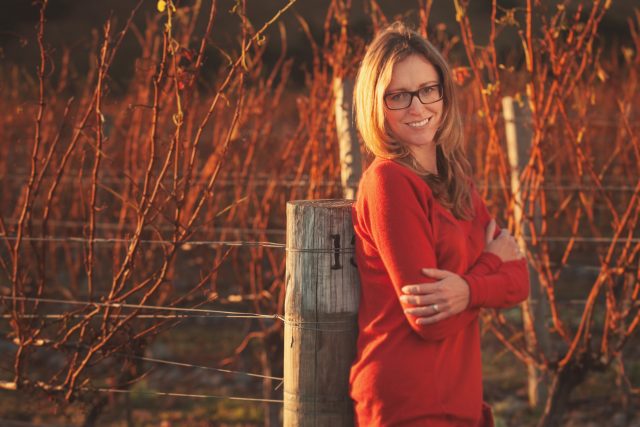
Seresin Winemaker Tamra Washington still sees so much untapped potential in Marlborough Sauvignon Blanc, with biodynamic farming, whole bunch pressing, wild ferments, and extended lees contact adding to her wines’ complexity.
On a closing note for this Sauvignon Blanc-loving post, I wanted to get a little more of a grasp of what impact wild ferments have upon the grape, as I have so often found myself drawn to Sauvignon Blanc wines crafted in this particular manner, and who better to ask than Seresin Winemaker Tamra Washington.
Good Food Revolution: What would you say differentiates Seresin Sauvignon Blancs from the majority of Marlborough Sauvignon?
Tamra Washington: Firstly, our Sauvignon Blanc is crafted from Select parcels of Organically and Biodynamically farmed fruit. This automatically lowers our yields naturally and contributes to the overall health of the soil, vines, and above all, the fruit. Berries tend to be smaller and skins thicker. This helps to prevent disease.
We then hand harvest all of our fruit, leaving out any bunches that are not looking lovely. The whole bunches are pressed gently, and the wine crafted with a philosophy of minimal intervention. We do not use any enzyme to clarify the juices or cultivated yeasts (we only use wild yeast), and follow a path to use less preservative (SO2). We also do not use any fining agents to modify taste or flavour.
A portion of the wine is aged in old French oak barrels and puncheons, and we also include a small proportion (approximately 5%) of Semillon. We also bottle our wines later and keep the components aging on lees for up to 8 months in the winery before blending and bottling. In some years, the wine will partially undergo malolactic fermentation.
To summarise, we are following a philosophy to build more texture and complexity into the wine, without losing the precise acidity or vibrant fruit that Marlborough Sauvignon Blanc is known for. The result is, hopefully, a wine that is elegant, age worthy, perhaps gentler and more‘ old world’ in style.
Good Food Revolution: Tell us a little about the way in which wild yeast changes the aromatics, taste, and texture of the Sauvignon Blanc varietal?
TW: Wild yeast can really bring the character of the vineyard into the glass. Less up front primary fruit is promoted during wild fermentation, and you can find more earthy, savoury notes – and in some cases more funk & sulphide.
Wild fermentations are more difficult, generally slower and longer, and I believe this can really build more texture and depth of flavour into the wines. During these longer fermentations, the wines can also start to undergo Malolactic fermentation – this can soften the sometimes, tight acidity that can be present in Marlborough Sauvignon Blanc, and bring a lovely richness and complexity to the wine.
And on that note, I’d like to propose a toast to International Sauvignon Blanc Day!
Try it out… you may find out that you like or love it.
This piece was assembled with the assistance of New Zealand Wine.
New Zealand Wine are Good Food Fighters.
Please support the businesses and organizations that support Good Food Revolution.

Edinburgh-born/Toronto-based Sommelier, consultant, writer, judge, and educator Jamie Drummond is the Director of Programs/Editor of Good Food Revolution… And Happy Sauvignon Blanc Day!

